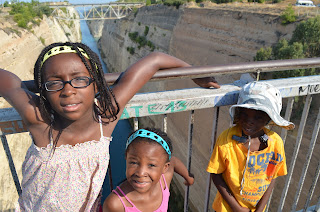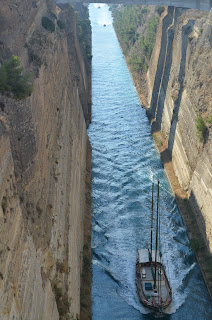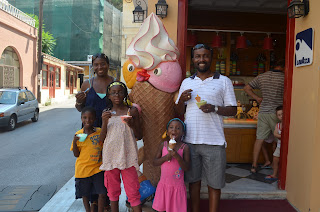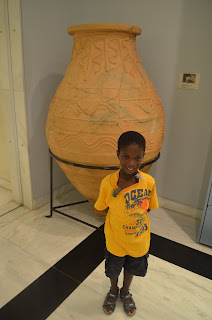Corinth Canal
Conceived centuries ago, work started under Emperor Nero in AD67 but it was finally built between 1882 - 1893. Before the canal was built , ships either had to sail all the way around the Peloponnese or use a road over which the ships were dragged with rollers. This was phenomenal accomplishment, facilitating trade and shipping at the time. It is a pretty narrow canal so really big ships cannot pass through. We enjoyed looking down at a couple of pleasure craft that were passing through.
A palm reading machine with the face of a Gorgon right by the canal.
You can take a cruise through the canal
Someone enjoying a pass through the canal - see the sheer rock walls coated with cement
Ancient Corinth
This was one of the largest Roman cities in Greece. St. Paul had numerous encounters with the city. He wrote two letters to the Corinthians. Paul came here around AD 52. In the Acts of the Apostle, he was brought to the Proconsul of Achaia- Gallio here by the Jews on the charges of introducing christianity to the locals. Act. 18 1-17. The city gained a reputation for licentious living and Paul was concerned about the new Christians . The Romans destroyed the city in 146 BC, and rebuilt it a century later. It was later destroyed in an earthquake.
Temple of Apollo
The Bema: The place where the Roman Proconsel held his tribunal in the Agora (marketplace) of Ancient Corinth. This is where St. Paul was brought and accused of spreading heresies among the Jews.
The Lechaion Way: the marble-paved road that linked the city to the port.Nafplion
This is a beautiful city that was the first capital of Greece after the War of Independence. It was an important city in Byzantine times and was controlled at different times by the Turks, Venetians, and Greeks. The city still has Venetian walls and a Venetian fortress - The Palamidi Fortress. This fortress was the site of the prison of a Greek field Marshal and one of the leaders of the Greek War of Independence against the Turks - Theodorus Kolokotronnis. He defeated the Ottoman Army and after Independence was accused of treason, sentenced to death, spent time in a hole in the fortress and was released a year later. He becamevery popular and learnt to write in his old age so he could write his memoirs which proved wildly popular. His reputation has been rehabilitated and there are statues of him in Nafplion and Athens and he was on the old Greek currency - the 5000 Drachma note. (Interesting but he does not appear in the guidebooks, our driver Nick told us about him).
At a Lookout point at the Palamidi Fortress:
Lighting candles at a Greek Orthodox church on the fortress grounds:
Inside the prison where Kolokotrones spent a year:
Another Lookout Point
Lunch at a Souvlaki/Gyro spot in Nafplion
Getting the best gelato in Nafplion - between us we had the following flavors - Bubblegum, Vanilla, Lemon, Melon, Mojito, Pistacho, and Hazelnut. Great Stuff !!!!!!!!!!
Mycenae
Next up was the seat of the mighty Kingdom of Mycenae which ruled a large portion of the Meditarranean from 1500BC to 1100BC and came after the Minoan civilization which we saw in Crete. Click here to read about our visit. This Kingdom is the beginning of the recognizable Greek state that we see today. It is the Greece of Myth and Fable. This was the Kingdom of Agamemnon of the Trojan War fame and the land was described by Homer as "rich in gold". The works of Homer and the classical plays by Sophocles, Aeschylus, and Euripides all cover the rulers of Mycenae
Mycenae - a UNESCO Heritage site
The Lions Gate: Erected in 13th Century BC. This was the entrance to the Acropolis/Palace of the Mycenaen Kings.
Treasury of Atreus dating from the 13th century BC. The tholos tombs where Mycenae's king was buried. According to Pausanias (a Greek traveler/Geographer/Writer from 2nd AD) this was known as the Tomb of Agamemnon in antiquity.
In the Museum - Standing by a pithoi which was used to store grain.


































No comments:
Post a Comment